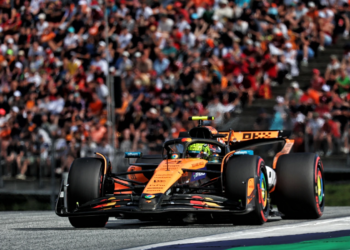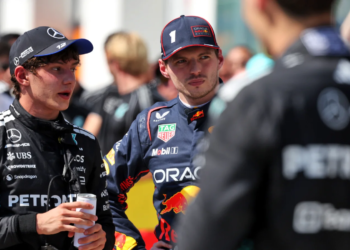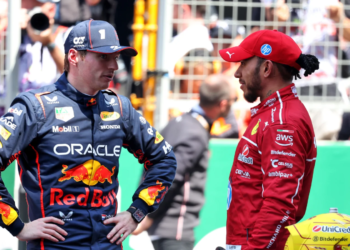The Formula 1 paddock is a bustling environment that features more than just drivers. Through 2019 Motorsport Week will be delving behind-the-scenes to bring insight to elements of Formula 1 beyond the race track. In this edition we catch up with Dave Freeman, Hospitality Manager of Honda, to discuss the challenges of catering for a Formula 1 operation that has a distinct Japanese flavour.
Each of the 10 Formula 1 teams have hospitality for its drivers, employees, media and other assorted guests, while engine supplier Honda, tyre company Pirelli, governing body the FIA and Formula One Management also have units. At European grands prix each team has a motorhome (of varying sizes, while Red Bull and Toro Rosso share), and at ‘flyaway’ events identical purpose-built or temporary structures house each of the 14 organisations.
At Honda the person responsible for looking after hospitality is Dave Freeman, a 20-year veteran of Formula 1 whose imaginative nickname is… Honda Dave.
“We’ve been with Honda on and off now for 15-20 years and we specialise in Japanese food,” explains Freeman. “They basically started my company. Honda have been magnificent with us, they put us through training. We’ve got a niche market and a little bespoke to what they need. They need us and we need them.”
Most Formula 1 operations are Europe-focused but Honda’s Japanese heritage means it is catering for a specific cuisine. It is unique in the paddock in employing its own highly-trained sushi-licensed Japanese chef, who works adeptly in the various kitchen environments. But cooking the food is one aspect – sourcing it is another entirely different challenge altogether. Formula 1, after all, visits 21 different locations each year.
.jpg)
“It makes it a little bit more complicated than most teams,” he explains of the Japanese influence. “Bahrain is the perfect example. You can go to the local Carrefour supermarket and pick up chopped tomatoes and basil for Italian food. You try and find me some unagi or some wakame, you just can’t! And so that logistically is very difficult. The flyaways are much more difficult on the logistics, the quality of the fish… there’s some fairly dangerous high-level ingredients that we will use when it’s safe to use. In certain places we don’t use raw egg yolks or raw fish as fundamentally we’ve got to make sure the food is safe before it’s flavoursome. That’s imperative. We do so many raw things we’re really critical on that. Each race has its own challenges.”
At some flyaway events ambient food – such as soy sauce, miso, wakame, rice and sake – is allowed to be taken in containers, but at other events import and export restrictions means that’s not permitted. That leads to some local shopping expeditions, but it’s not simple. At one grand prix Freeman has to travel just 23km from the circuit to the respective Japanese supermarket, but the traffic jams means it turns into at least a five-hour round trip.
.jpg)
“At some events the Japanese cuisine isn’t there and they don’t have a fish cuisine,” he says. “Everything’s cabbage and pork and heavy stuff. And I can understand. Why would they want to be a supplier of fresh turbot when nobody eats it there?” Expiry dates can also be a challenge. “It’s come from a supplier in Japan, imported to England – that’s eight weeks – then it’s gone to my warehouse, then it’s gone to a sea freight container, gone to somewhere such as Baku, lo and behold it’s gone out of date.” European events are more straightforward, not just because of the shorter distances involved but also because Honda has a freezer truck it uses for the events. “If we’ve got a fresh, perfect loin of salmon on Sunday I’d freeze that down and we’d grill it at the next race,” he says. That isn’t possible at non-European events, bringing the subject onto a delicate area. Food waste, unfortunately, is an issue. It is one that clearly pains Freeman. “I’m contracted to provide X amount of food for X people, and the reason I’ve done it for 20 years is I’ve never run out of food. But I have thrown away a lot of food. And it does break your heart. And people do talk about charities and things like that. But in reality you can’t get the passes in, you can’t get vehicle passes, and the food hygiene laws are another problem.” There was a proposal one in India one year for teams to collaborate and donate leftover food to the local area, but bureaucracy prevented such a development.
.jpg)
Honda is in a slightly different situation to most Formula 1 organisations in that it caters predominantly for its engine mechanics, rather than a fully-fledged team, and it has minimal guests or sponsors. Its motorhome for European races is stylish and understated – “the Honda way” – while its association with two teams means its employees can also eat at Red Bull or Toro Rosso, should they so desire. Freeman is full of praise for the manner in which Honda looks after its team members – just that morning they have flown in a specific type of noodle from Japan – while the Japanese approach to life also assists his cause.
“The thing that’s a huge difference is breakfast,” he explains. “The Japanese breakfast is so different to a European-style breakfast. You have rice, a grilled fish, a hot kobachi, which is a side dish – so today was a potato and carrot stew – you’ll have miso soup. You’ll have a seaweed dish. There’ll be fruit. It’s a huge meal. For lunch we do the bento boxes – which is a packed meal – on Friday, Saturday, Sunday, so we try and westernise it a bit. But the Japanese are so focused. This is another thing. The Japanese are totally focused and will miss lunch. No problem. Europeans manage to fit it in in their daily routine! As long as they’ve [the Japanese] had a big breakfast, if we do the bento boxes – and sometimes they don’t have time to eat them – then they’re ready for dinner. They can last as they’re so focused.” Freeman is also full of praise for the flexibility of Japanese team members, understanding that, in spite of his best efforts, he cannot always source the exact ingredients. But there’s one element that never changes.
.jpg)
“Our pack down meal [on a Sunday] is a katsu curry,” he explains. “We’ve done it for 20 years. The truckies and Europeans say ‘oh I don’t like Japanese food… don’t like curries’, and I say ‘just try it’, and they’re like ‘f***ing hell Dave that’s the nicest curry I’ve ever had in my life!’ A lot of Japanese food is cooked. It’s not all raw salmon and raw egg yolks.” Freeman nonetheless does cater for European palettes, where possible – for example offering roast beef or a chicken Kiev – but the Japanese products take priority, particularly with aspects such as oven and storage space to consider.
In the two decades of travelling with Formula 1 there have been a few eye-opening encounters for Freeman. Cultural differences meant that the sight of three men slitting the throat of a cow outside of a supermarket – in the middle of a city – was entirely normal at one grand prix, while logistically there have been scares. Prior to one event Honda’s entire cargo was left off the ship at the Port of Felixstowe but Formula 1’s official supplier paid through the nose to ensure it was air freighted on time. More than a few sighs of relief were had that day.
.jpg)
Drivers over the years have visited Honda’s hospitality for meals as many enjoy Japanese cuisine, courtesy of its health benefits and relative lightness compared to occasionally bulky European food. Brendon Hartley and Stoffel Vandoorne were regular visitors while Pierre Gasly often appears. But they are (or were) Honda-linked drivers. A while back Freeman had to put a stop to others turning up. Not through spite, but through other factors, explaining: “Michael Schumacher for instance, he was very fond of Japanese food. We’d do some sushi for him, after qualifying, him and [wife] Corinna, so that was pleasant. It got a little bit over the top as there used to be seven drivers and you think ‘hold on here we taking a bit of a risk on litigation in case there was a problem’ – imagine a Honda chef poisons all of these! I used to do a nice plate of sushi for Michael, on a black plate, I’d brought especially from Japan. At one event his mother was dying, and he flew back home to be there, and came back [the next day] to the circuit. I went to see him at the following race and I went to his physio, ‘I’m very sorry about [his mother] but what’s happened to my black plate as I’d like to do it [a sushi meal] for him’ – and he said Michael took it on the plane. I thought… ‘hold on here the plane is taking off a like 9/10pm at night, I’ve made that at 2pm in the afternoon!’ After that I had to stop doing it for other drivers as we were taking a risk!
“But I’ve got this wonderful picture with him when he’d called me into the Ferrari garage when I was working with Williams and he wanted a picture. I walked into the Ferrari garage, at the time it was whoever won Suzuka won the championship. Jean Todt was there. They were all looking at me in my Williams kit and all thinking ‘who the f*** is this guy’! Michael was there, we took the picture, he signed it ‘to my sushi chef,’ what a gentleman.”
Stay tuned to Motorsport Week throughout 2019 for more behind-the-scenes insight into Formula 1 paddock life.






